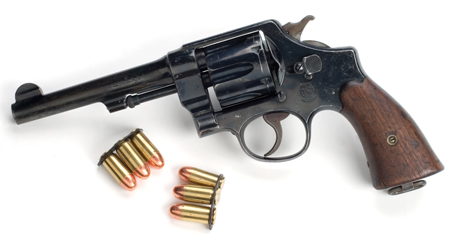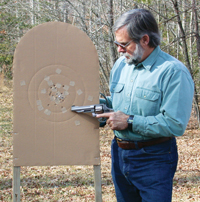
S&W continued to produce the Second Model after World War I. Once again, the most popular caliber was the .44 Special with the .45 ACP a distant runner up while smaller numbers were produced in .38-40, .44-40, .45 Long Colt and .455 Webley. Another variation, the .44 Hand Ejector, Third Model was produced in 1926 on special order from the Wolf & Klar Company, a firearms distributor in Fort Worth, Texas. It was basically a .44 Special caliber Second Model with an ejector rod shroud and proved popular enough that limited numbers were produced up until 1950.
In 1937 the Brazilian government placed an order for 25,000 Second Models in .45 ACP. Known as the Modelo 1937 they were – except for the fact that some were fitted with checkered rather then smooth grip panels – identical to U.S. issue M1917s.

During World War II the army and USMC issued M1917s once again. While primarily used by military police and support troops, quite a few turned up in combat where they again gave a good account of themselves. In addition, large numbers were supplied to our British and Chinese allies.
Production resumed after World War II as the .45 Hand Ejector Model of 1917. In 1950 S&W began offering two slightly updated revolvers, the .45 Hand Ejector Model of 1950 with fixed sights and the .45 Hand Ejector Model of 1950 Target with a ribbed 6.5-inch barrel and adjustable sights. The latter was superseded two years later by the heavy-barreled .45 Hand Ejector Model of 1955 which, after 1957, was known as the Model 25.
Lest we get too far ahead of ourselves and become confused, let us backtrack for a moment. The post-World War I years saw a massive switch by U.S. police to medium-frame revolvers chambered for the .38 Special cartridge, and S&W’s .38 Military & Police soon became the “standard” revolver in the holsters of most police officers in the Western hemisphere.
The 1920s and 1930s were times of great social change and economic unrest which led to the rise of a new breed of violent criminals. The proliferation of the automobile, combined with poor communications and lack of coordination between police agencies, provided these lawbreakers with the means to commit crimes, escape quickly, and elude pursuit. In addition, the heavy gauge steel auto bodies of the day provided excellent protection for these highly mobile banditti.
Gunfights between police and automobile-mounted robbers led to a call for a handgun cartridge capable of defeating auto bodies. In response, several ammunition companies loaded the .38 Special with a 200-gr. lead bullet at a velocity of 730 fps for 236 ft/lbs. of energy. Often referred to as “Super Police” or “Highway Patrol” loads, they nevertheless proved inadequate. Also, medium-frame revolvers tended to loosen up or go out of time when fed a steady diet of them.

In 1930 S&W came to the rescue with a revolver that, over the years, has been known by several names: .38/44 Heavy Duty, .38/44 Hand Ejector or .38/44 Super Police. It was in fact, little more than the fixed-sight .44 Hand Ejector rebarreled and chambered for the .38 Special and fitted with an ejector rod shroud. It proved to be a rugged, no-frills handgun capable of digesting a unlimited diet of heavy-bullet .38 Specials and became especially popular with rural sheriff’s departments and Highway Patrol agencies in the western and southern states.
In 1931, Remington developed a high-performance .38 Special loaded with a 158-gr. hardened lead bullet which, when fired from a 6.5 inch barrel, attained a velocity of 1175 fps, producing an impressive 460 ft/lbs.of muzzle energy. While Remington called it the .38/44 S&W Special Hi-Speed, it quickly became known simply as the “.38/44.” It was also available loaded with a 150-gr. metal pointed bullet at the same velocity, a round that had no trouble whatsoever penetrating auto bodies, walls and the primitive bullet proof vests of the day. [This .38/44 load is not to be confused with the earlier, similarly-named .38-44 S&W, a special target cartridge chambered in a variant of the S&W Model 3 large-frame, top-break revolver. –DMS]
That same year, S&W offered a second version designed for sportsmen and target shooters. The .38/44 Outdoorsman came with a 6.5-inch barrel, a fully-adjustable rear sight and a patridge front sight. The .38/44 revolvers retained their popularity throughout the 1930s and ‘40s although production ended in 1941 so S&W could concentrate on war orders. Production resumed after the war and in 1957 the .38/44 was rechristened the Model 20 while the Outdoorsman became the Model 23. But the increasing popularity of the .357 revolver led to declining sales, and manufacture of both ceased in 1967.

One of the more notable events in firearms history occurred in 1935 when S&W’s Philip Sharpe, in cooperation with Winchester’s Merton Robinson, introduced the .357 S&W Magnum cartridge. Based on the venerable .38 Special case lengthened by one-eighth of an inch, the original load propelled a 158-gr. bullet to approximately 1500 fps (from an 8-3/4-inch barrel), qualifying as the most powerful handgun cartridge of its era. (Note: the velocity of factory-produced .357 ammunition was later reduced to the 1200-1300 fps range.)
The first revolvers available chambered for the .357 were based on S&W’s N-frame and were dubbed, appropriately enough, the .357 Magnum Hand Ejector. S&W’s new Magnum revolver was a deluxe item featuring the highest levels of craftsmanship and finish. All .357 Magnums were custom-made and were fitted with a fully adjustable rear sight while the buyer had the options of seven different front sights, any length barrel from 3-1/2 to 8-3/4 inches and several different styles of grips.
In an obvious attempt to attract the attention of the law enforcement community, S&W’s president presented revolver serial #1 to FBI director J. Edgar Hoover on May 10, 1935. But while the .357 Magnum was beyond the budget of most 1930s police agencies, the cartridge’s performance quickly earned it an enviable reputation and in pre-World War II years it became a status item among both civilian shooters and law enforcement personnel.
And while some affluent agencies issued them, many more were purchased with private funds by officers wanting the “best.” In the post-war years .357 Magnum Hand Ejector production continued and in 1957 it was rebaptized the Model 27. (It’s worth noting that the first 5,500 .357 Magnums were registered to their original purchasers. Today these guns are called “registered Magnums,” and their value is somewhat higher than non-registered Magnums of the same vintage, all other factors being equal.)
Click Here to Read Part I
Click Here to Read Part III
This article is an excerpt from the Gun Digest 2011 annual book.

Next Step: Get your FREE Printable Target Pack
Enhance your shooting precision with our 62 MOA Targets, perfect for rifles and handguns. Crafted in collaboration with Storm Tactical for accuracy and versatility.
Subscribe to the Gun Digest email newsletter and get your downloadable target pack sent straight to your inbox. Stay updated with the latest firearms info in the industry.

![Best Concealed Carry Guns In 2025 [Field Tested] Wilson Combat EDC X9S 1](https://gundigest.com/wp-content/uploads/Wilson-Combat-EDC-X9S-1-324x160.jpg)


![Best 9mm Carbine: Affordable PCCs [Tested] Ruger Carbine Shooting](https://gundigest.com/wp-content/uploads/Ruger-Carbine-Shooting-100x70.jpg)
![Best AR-15: Top Options Available Today [Field Tested] Harrington and Richardson PSA XM177E2 feature](https://gundigest.com/wp-content/uploads/Harrington-and-Richardson-PSA-XM177E2-feature-100x70.jpg)
